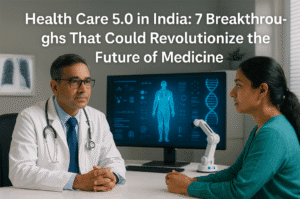Health Care 5.0 in India: 7 Breakthroughs That Could Revolutionize the Future of Medicine
India’s transition to Health Care 5.0—a fusion of AI, robotics, and personalized medicine—holds transformative potential, promising precision diagnostics, remote surgeries, and data-driven treatments. While initiatives like Ayushman Bharat Digital Mission and startups in AI diagnostics showcase progress, deep-rooted challenges persist. Urban-rural divides in infrastructure, erratic internet access, and outdated systems hinder nationwide adoption.
Policy gaps around data ethics, workforce readiness, and affordability risk exacerbating inequalities, as cutting-edge care remains concentrated in urban hubs. Success demands robust public-private partnerships to expand rural connectivity, updated medical training integrating AI literacy, and ethical frameworks to prevent bias in tech-driven solutions. India’s genetic and socioeconomic diversity positions it as a unique testbed for scalable innovations, but balancing high-tech ambitions with grassroots realities is critical.
Without equitable policies and investments, Health Care 5.0 could deepen disparities rather than democratize access. The path forward hinges on blending human expertise with technology—ensuring innovations serve not just cities, but villages where healthcare gaps are starkest.

Health Care 5.0 in India: 7 Breakthroughs That Could Revolutionize the Future of Medicine
As the world inches toward a new era of hyper-personalized, tech-driven medicine, India stands at a pivotal juncture. Health Care 5.0—a fusion of human expertise, AI, robotics, and genomics—promises to revolutionize everything from diagnostics to drug discovery. Yet, for a nation grappling with stark urban-rural divides and systemic inequities, the leap to this future demands more than innovation; it requires reinvention.
The Vision of Health Care 5.0: Beyond Buzzwords
Health Care 5.0 isn’t merely an upgrade—it’s a paradigm shift. Imagine AI algorithms predicting cardiac events months in advance by analyzing wearable device data, or nanobots delivering chemotherapy directly to cancer cells. “Digital twins,” virtual replicas of patients, could simulate how a diabetic’s body reacts to new drugs, eliminating trial-and-error treatment. For India, where 70% of healthcare infrastructure is urban but 65% of the population lives rurally, such technologies could democratize access. Tele-robotics, for instance, might enable a surgeon in Delhi to operate on a patient in Bihar via 5G-connected robotic arms.
But these possibilities hinge on solving foundational challenges.
India’s Progress: A Tale of Two Systems
India has made strides in digitizing healthcare. The Ayushman Bharat Digital Mission, with its 500 million+ registered health IDs, and startups like Qure.ai (using AI to interpret X-rays) or Tricog (cloud-connected ECG analysis) showcase potential. Yet, these successes often exist in silos. Private hospitals in metros deploy AI-driven imaging tools, while rural clinics lack basics like reliable electricity.
Dr. Ravi Kumar, a public health expert, notes, “We’re witnessing islands of excellence in a sea of deprivation. A patient in Mumbai might receive a 3D-printed implant, but another in rural Odisha travels 50 km for an X-ray.”
The Roadblocks: Where Ambition Meets Reality
- Infrastructure Asymmetry: High-speed internet, essential for AI or tele-robotics, reaches only 47% of rural India. IoT-enabled devices are futile in areas with frequent power outages.
- Policy Paralysis: While the Digital Personal Data Protection Bill (2023) is a start, regulations lag behind tech advancements. Who owns patient data generated by AI? How are biases in algorithms addressed? Ambiguities persist.
- Workforce Readiness: India has 0.7 doctors per 1,000 people (WHO recommends 1:1,000). Upskilling this strained workforce to collaborate with AI—not just operate it—is critical. A nurse interpreting AI alerts or a surgeon guiding robots requires new training paradigms.
- Ethical Dilemmas: Personalized medicine’s cost could exacerbate inequities. Will genomic therapies be accessible only to the affluent?
Blueprint for a Collaborative Future
Bridging the Digital Chasm:
- Public-Private Partnerships: Collaborate with tech giants to expand 5G and solar-powered health hubs in rural areas. Andhra Pradesh’s “e-Hospital” initiative, digitizing 147 hospitals, offers a template.
- Modular Tech: Deploy low-bandwidth AI tools, like Google’s AI-powered tuberculosis detection, which works offline.
Policy Innovation:
- Sandbox Regulations: Create testing zones where startups can pilot AI diagnostics under regulatory oversight, accelerating approvals while ensuring safety.
- Data Sovereignty: Localize health data storage to build trust and comply with privacy norms.
Workforce Transformation:
- Medical Education 2.0: Integrate AI literacy into MBBS curricula. AIIMS Delhi’s workshops on robotic surgery are a start.
- Community Health 5.0: Train ASHA workers to use handheld AI devices for early disease detection in villages.
Ethical Guardrails:
- Equity-First AI: Mandate transparency in algorithms to prevent bias. For example, ensure AI tools are trained on diverse Indian genetic data, not just Western datasets.
- Subsidized Innovation: Price caps on AI diagnostics or government-funded genomic banks could democratize access.
The Untapped Opportunity: India as a Global Testbed
India’s diversity—genetic, socioeconomic, and climatic—positions it uniquely to stress-test Health Care 5.0 solutions. A drug tested on India’s varied population could have global relevance. Startups like Niramai (AI for breast cancer screening) and SigTuple (AI-powered blood analysis) are already attracting global investors.
Conclusion: The Human Factor in a Tech-Driven Vision
Health Care 5.0 isn’t about replacing doctors with robots but amplifying human expertise. Success hinges on balancing ambition with empathy. As Dr. Devi Shetty, cardiac surgeon, observes, “Technology can bridge gaps, but trust is built by human touch.” For India, the goal is clear: Harness innovation to create a system where a farmer in Vidarbha receives the same precision care as a CEO in Bangalore. The road is arduous, but the stakes—millions of lives—are worth the climb.
The clock is ticking. With strategic investments and inclusive policies, India could pioneer a healthcare model that blends cutting-edge tech with grassroots realities—a blueprint for the Global South. If not, it risks becoming a market for foreign solutions, rather than a creator of homegrown ones. The choice is now.
You must be logged in to post a comment.